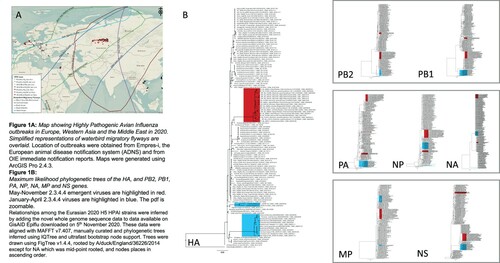Figures & data
Figure 1. (A) Map showing highly pathogenic avian influenza outbreaks in Europe, Western Asia and the Middle East in 2020. Simplified representations of waterbird migratory flyways are overlaid. Location of outbreaks was obtained from Empres-i, the European animal disease notification system (ADNS) and from OIE immediate notification reports. Maps were generated using ArcGIS Pro 2.4.3. (B) Maximum likelihood phylogenetic trees of the HA, and PB2, PB1, PA, NP, NA, MP and NS genes. May–November 2.3.4.4 emergent viruses are highlighted in red. January–April 2.3.4.4 viruses are highlighted in blue. The pdf is zoomable. Relationships among the Eurasian 2020 H5 HPAI strains were inferred by adding the novel whole genome sequence data to data available on GisAID Epiflu downloaded on 5th November 2020. These data were aligned with MAFFT v7.407, manually curated and phylogenetic trees inferred using IQTree and ultrafast bootstrap node support. Trees were drawn using FigTree v1.4.4, rooted by A/duck/England/36226/2014 except for NA which was mid-point rooted, and nodes places in ascending order.

